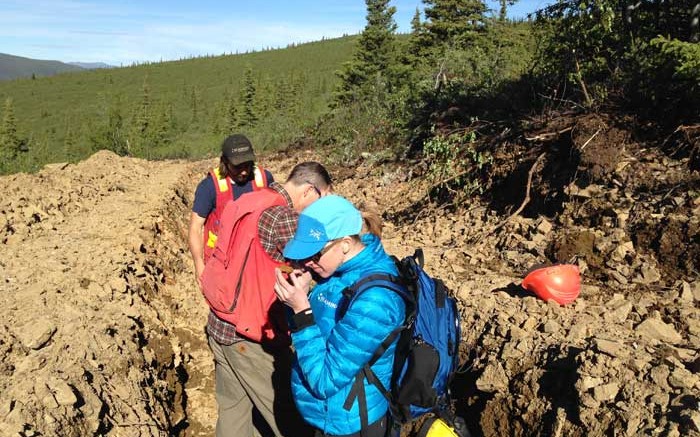Kaminak Gold (TSXV: KAM; US-OTC: KMKGF) president and CEO Eira Thomas says the company’s high-grade and potentially high-margin Coffee gold project in the Yukon would be simple to mine and process.
“What we really like about this project is it’s straightforward. It’s about as vanilla as it gets,” she said in a September presentation.
Since discovering the multi-deposit project 130 km south of Dawson City in 2010, the debt-free junior has drilled 200,000 metres and delineated 4 million oz. gold in indicated and inferred. The project now hosts 14 million indicated tonnes grading 1.56 grams gold for 719,000 oz., plus 79 million inferred tonnes at 1.36 grams gold for 3.4 million oz. These resources are in the Latte, Supremo, Double Double and Kona deposits.
“What’s curious about this part of the Yukon and a big value driver for Coffee is that this particular part of the Yukon has never been glaciated. So as a result, our deposits have developed a deep weathering profile. And of our 4 million oz. resource about 2.6 million oz. qualify as oxide — and that is a really key element of our story,” Thomas said. Oxide ounces are easier and cheaper to extract and process.
In June, Kaminak published a preliminary economic assessment (PEA), where it modelled a $305-million open-pit heap-leach mine producing an average of 167,000 oz. gold per year over 11 years, at all-in sustaining costs of US$688 per oz.
“By virtue of the grade of the deposits and the good metallurgical recoveries that we are getting, we have been able to develop all-in sustaining cash costs of well under US$700 an oz., providing a 42% margin or over US$560 an oz. at current gold prices — so strong margins for this project,” she said.
Over its mine life, Coffee would have a 4-to-1 strip ratio, with Kaminak extracting 53 million tonnes at a diluted grade of 1.23 grams per tonne to produce 1.86 million oz. gold at an 88% recovery rate.
The project’s economics appear encouraging. Using a US$1,250 per oz. gold price and a 5% discount rate, the after-tax net present value is US$330 million, with a 26% internal rate of return. Payback should occur within two years.
After the PEA, Kaminak closed a $13.5-million private placement with Ross Beaty and Zebra Holdings (the trust of the late Adolf H. Lundin) in July, giving each investor a 9.9% stake in the company.
At the end of that month, Kaminak kicked off a feasibility study that included infill drilling, more metallurgical test work, environmental baseline activities and continued a condemnation program.
In September the junior reported positive results from its $3.5-million phase-one exploration drilling campaign, including a new gold zone called Kona North. The objective of the program was to test gold-in-soil anomalies near the current resource that could add oxide resources to the existing mine plan.
The 27-hole campaign found shallow, predominately oxidized gold-bearing structures within the Kona North zone with discovery hole hitting 28 metres of 3.55 grams gold. It also extended mineralization 900 metres along strike on the Supremo T3 trend and hit high-grade mineralization at the Cappuccino zone.
Given the program’s success, Kaminak immediately started a $2 million, phase-two exploration campaign, targeting Kona North and other gold-in-soil anomalies near the current resource.
In October, follow-up drilling at Kona North traced mineralization over a strike length of 240 metres. So far the junior has completed 10 holes and 2,000 metres on the 1.5 by 0.5 km anomaly, including the two holes and 400 metres it had drilled in phase one.
Mineralization at Kona North appears to be associated with an east- to west-trending structural corridor that remains open along strike and to depth, with varied oxidization that occurs near surface and extends to an average 40-metre depth.
Kaminak intends to continue it drill efforts on Kona North in 2015 and delineate a near-surface oxide resource that may be included in the feasibility study, Thomas said.
“We’ve got great potential to expand our resources. We’ve really only explored 20% of the full geological potential at Coffee, and we got numerous priority untested targets,” she adds.
As part of the feasibility work, the junior is studying several opportunities to improve the project’s economics, including using coarser crushing or run-of-mine leaching, as well as contract mining to drive down capital costs. It is looking at alternative energy sources, such as liquefied natural gas to lower fuel costs.
“We really do think that we have got a great project in the right jurisdiction and we have got the right team to actually get it into production. And we are excited about the potential of this project in 2015,” Thomas said.
The company expects to complete the $30-million feasibility study late next year.


Be the first to comment on "Kaminak’s Coffee project ‘as vanilla as it gets’"